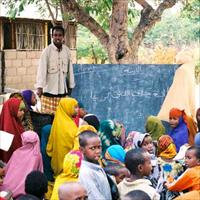Farm schools for vulnerable rural youth on the rise in Africa

Millions of orphans and vulnerable children in need of support – new manual published
Farm schools for vulnerable children affected by the HIV/AIDS epidemic are playing an increasingly important role in sub-Saharan Africa, FAO said today. The schools are teaching orphans vital farming and life skills ensuring them sustainable livelihoods and long-term food security.
A new manual on how to set up a Junior Farmer Field and Life School (JFFLS) has just been published by FAO and the World Food Programme (WFP).
HIV and AIDS have a tremendous impact on rural communities in Africa, particularly on children.
“Children and youth are charged with the heaviest burden of the AIDS crisis,” said Marcela Villarreal, Director of FAO’s Gender, Equity and Rural Employment Division. “Without their parents, they become more vulnerable to hunger and poverty, disease, conflict, sexual exploitation, forced migration and environmental degradation. The schools are an attempt to give orphans the means and the confidence to survive in an often very difficult environment,” she added.
The number of orphans and other vulnerable children is growing in sub-Saharan Africa as a serious consequence of the AIDS epidemic, conflicts and displacement. To date, sub-Saharan Africa accounts for more than 40 million orphans, with an estimated 11.4 million children orphaned by AIDS.
Schools in eleven countries
Since 2004, FAO has established highly successful JFFLS projects targeting several thousand youth in eleven African countries: Cameroon, Kenya, Malawi, Mozambique, Namibia, Sudan, Swaziland, Tanzania, Uganda, Zambia and Zimbabwe. Collaborating partners are national governments, non-governmental organizations, local institutions and WFP.
JFFLS seek to improve the lives of children and youth aged 12 to 18 years who live in food insecure communities where HIV and AIDS have had a strong impact, particularly in rural areas. As parents and family members become ill, children often become directly involved in food production and processing. As a result, young girls and boys may have to drop out of school, either temporarily or permanently.
During an entire agricultural season, a group of 30 boys and girls follow the life cycle of crops. The agricultural training covers field preparation, sowing, weeding, irrigation, pest control, use and conservation of available resources, food processing, harvesting, storage and marketing skills. The schools pay particular attention to teaching local agricultural production skills that have not been passed down because of the early death of parents.
“Students learn about preventing plant pests and diseases. In the same way, they learn that they can protect themselves against risks such as HIV/AIDS and other diseases,” Villarreal said.
The schools address a wide range of issues such gender sensitivity, child protection, psycho-social support, nutrition education and business skills. Experience has shown that the schools provide a safe and social space for boys and girls, enabling them to develop their self-esteem and confidence.
Food support, provided by WFP, is an essential part of the JFFLS program. “Providing a nutritional meal to children in the schools is both an incentive for them to attend lessons and gives them an energy boost to participate actively,” said Robin Jackson, Chief of WFP’s HIV/AIDS Service.
The local community plays an important role in monitoring and implementing the schools, including providing land and volunteers. A JFFLS is run by a small group of people, often including a local extension worker and a teacher.
Getting started
The new FAO/WFP manual Getting Started! Running a Junior Farmer Field and Life School provides details for staff of ministries and non-governmental organizations on how to set-up, operate and sustain a field school.
The manual is based on the experience of people working with rural vulnerable youth. It is generic and can be used in different regions of the world.
 Back and Next - Back and Next
Back and Next - Back and Next See Also - See Also
See Also - See Also